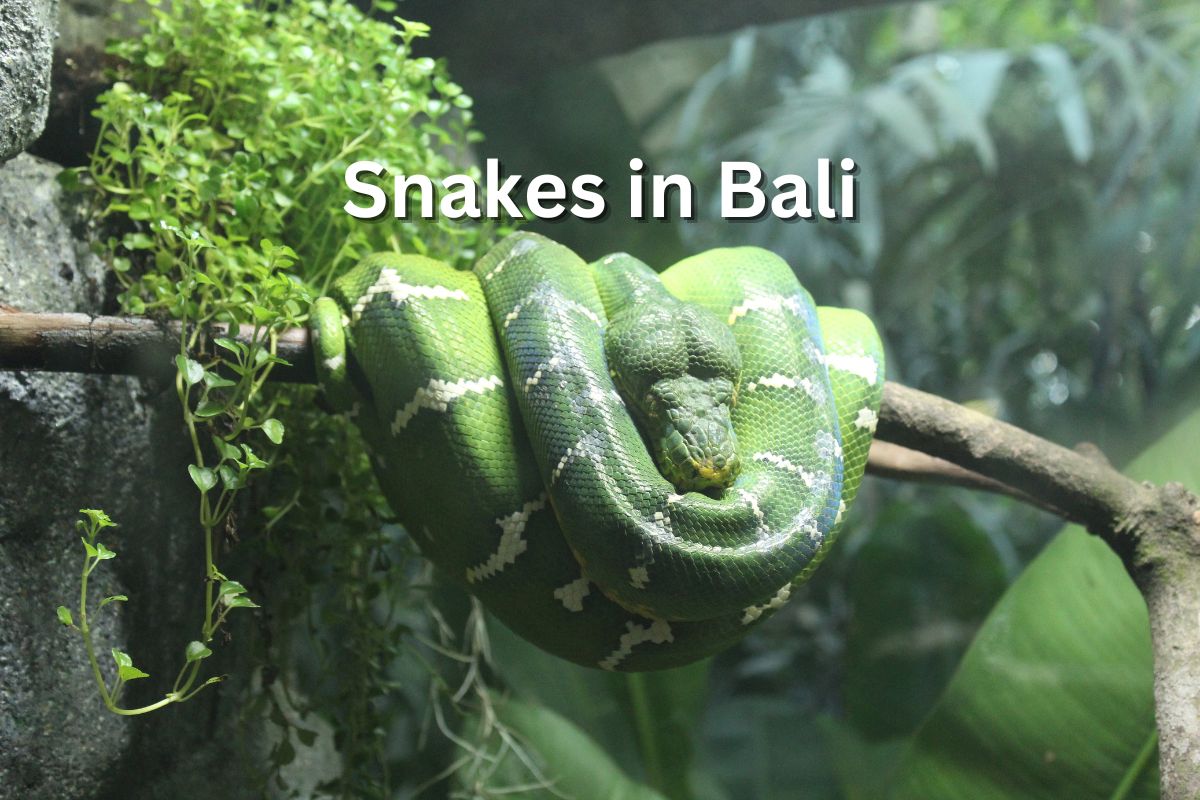Let’s talk about the amazing snakes of Bali and nearby islands. These wildlife creatures can scare a lot of people. For some it is a reason to avoid Bali all together! Knowing about these snakes is important. It keeps you safe and helps you understand nature better. Some snakes in Bali are safe, and some are not. It’s good to know which is which.
Snakes play an important in Bali. They keep too many rats from being around. This is good for the plants and farms. Some snakes even stop other snakes from being too many.
We are going to learn about these snakes. It’s exciting and will show us how important they are. Whether you love traveling, animals, or just want to know more this is made for you!
Where can you find the snakes in Bali?
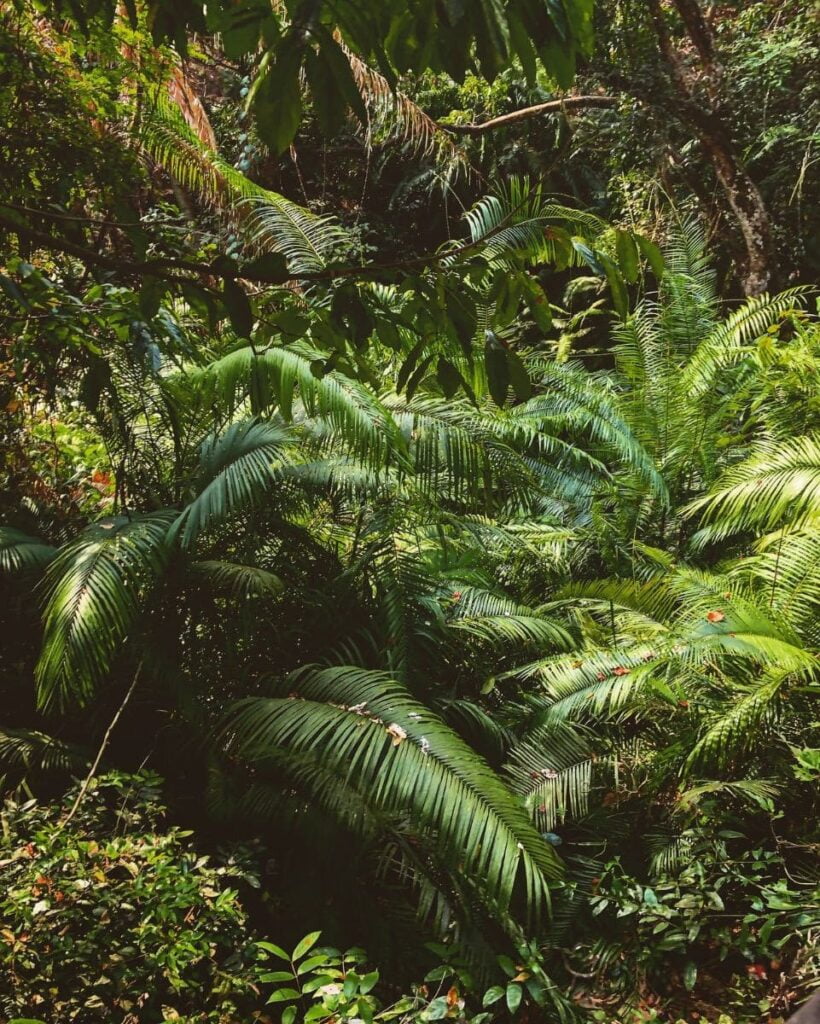
Snakes in Coastal and Inland Areas
Snakes often live in the coastal lowlands and hills. These places have lots of plants and open spaces. Snakes like it here because they can find food and hide easily. They eat small animals and stay safe in the thick plants.
River Valleys and Rice Fields as Habitats
Further inland, snakes are found in river valleys and rice fields. These areas are wet, which snakes like. Rice fields have many rodents, which are food for snakes. So, these places are good for snakes to live and find food.
Gardens and Less Crowded Places
Some snakes live in gardens or less crowded places. These areas have many plants and sometimes water. This makes them good for snakes to hide and find food. Snakes come here for shelter and to eat things like insects.
Forests: A Safe Home for Snakes
Bali’s forests, including mangroves, are important for snakes. These forests are quiet and not disturbed much. They give snakes a safe place to live. The forests have lots of food and are good for keeping the balance in nature.
Why Snakes are Rare in Hotels
Snakes are not often seen in hotels. Hotels are clean and busy, which these creatures don’t like. They prefer quiet places. Sometimes, small snakes come to hotels by accident, especially if the hotel is near a forest or a quiet place. Example of a tourist encountering a snake in Ubud Hotel and got bitten. The hospital gave the anti venoms so she survived! phew!
In Bali, understanding where snakes live helps us stay safe. It also shows us how important snakes are in nature. They help control pests and keep the balance in the environment.
Staying Safe Among Bali’s Snakes – Prevention and First Aid
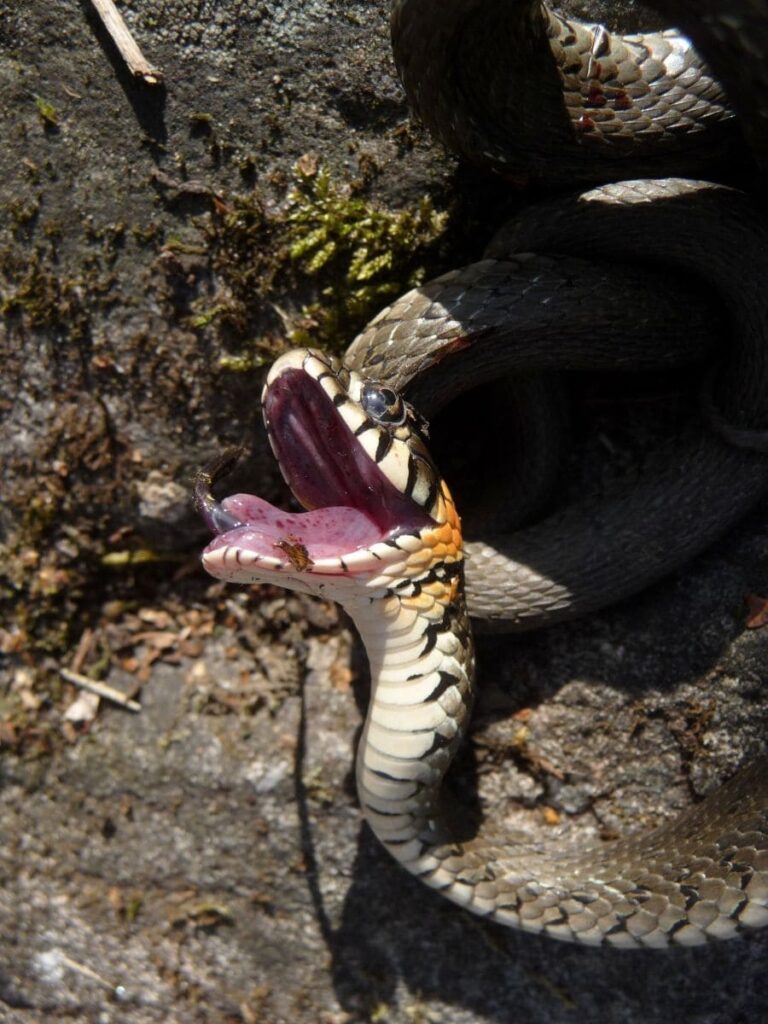
In Bali’s diverse landscape, encountering a snake is a possibility, though not a common occurrence. Let’s talk about how to avoid these encounters and what to do if you or someone else gets bitten. This advice comes from the insights we’ve gathered about Bali’s snakes.
Preventing Snake Encounters
- Be Aware of Your Surroundings: Most snakes in Bali prefer to avoid humans. When walking in areas with dense vegetation or near water bodies, stay alert.
- Avoid Walking Through Tall Grass: Snakes can hide in tall grasses. Stick to clear paths.
- Use Lights at Night: Many snakes are more active at night. Carry a flashlight to spot them easily.
- Keep Your Living Area Clean: Snakes come looking for food. Keeping your area clean reduces the chance of attracting rodents, which in turn attracts snakes.
First Aid for Snakebites If someone is bitten by a snake, quick action can make a big difference. Here’s a step-by-step guide:
- Stay Calm: Keep the bitten person calm and still. Panic can increase the heart rate, spreading the venom faster.
- Immobilize the Bitten Area: Keep the bitten limb as still as possible. Movement can spread the venom.
- Remove Constricting Items: Take off any jewelry or tight clothing near the bite.
- Do Not Cut or Suck the Bite: This can worsen the injury and increase the risk of infection.
- Seek Medical Help Immediately: Get to a hospital as soon as possible. The sooner the victim receives medical attention, the better.
Source: John Hopkins Medicine on Snake Bites: https://www.hopkinsmedicine.org/health/conditions-and-diseases/snake-bites
Emergency Contacts in Bali
- Hospitals: Sanglah Hospital (Prof. dr. I.G.N.G. Ngoerah General Hospital) in Denpasar ((0361) 227912) is well-equipped for snakebite treatments.
- Snake Removal Experts: For safe snake removal, contact the Bali Reptile Rescue (+62 821-4638-0270).
Common poisonous snakes in Bali
Let’s take a closer look at the venomous snakes, their venom potency, and what medical responses are needed in case of bites. This information is based on the content we’ve analyzed about Bali’s snakes.
Island Pit Viper
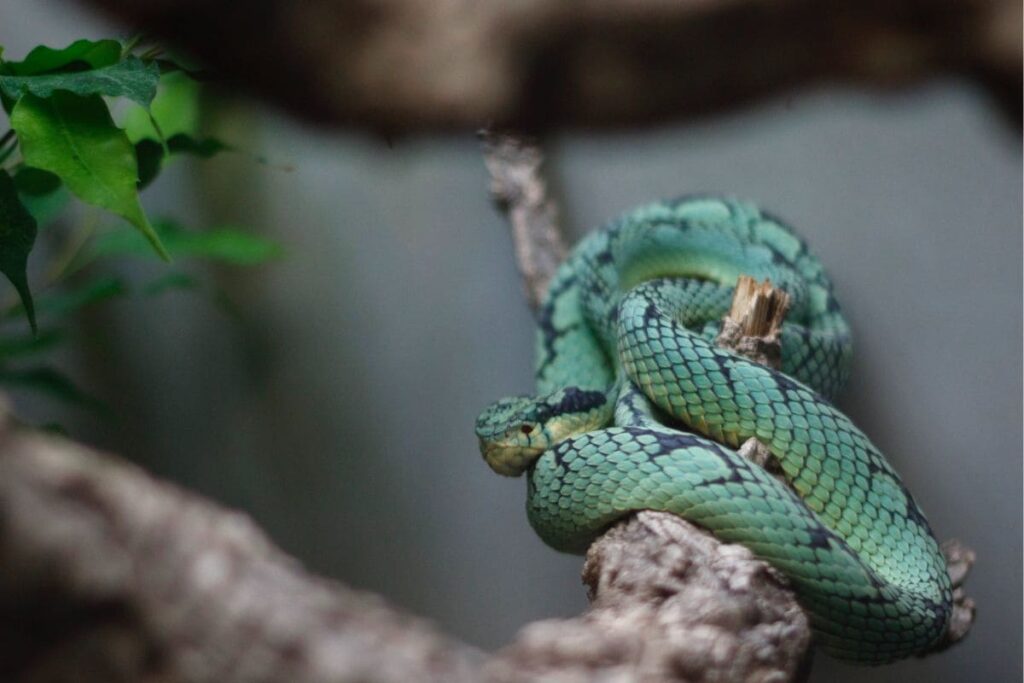
In Bali, the Island Pit Viper is a common sight. It’s bright green with a reddish-brown tail. This snake lives up to 1000 meters high. It blends in with the green leaves. But, its bite is dangerous. It can hurt your tissues a lot. In Bali, hospitals help with the pain and swelling. They don’t have a special medicine for this snake’s bite.
- Appearance: Usually bright green with a reddish-brown tail.
- Habitat: Found in coastal areas and up to 1000 meters inland.
- Venom Potency: Their venom can cause significant tissue damage. Immediate medical attention is crucial.
- Medical Response: There’s no specific anti-venom in Bali, but hospitals can manage pain and swelling.
King Cobra
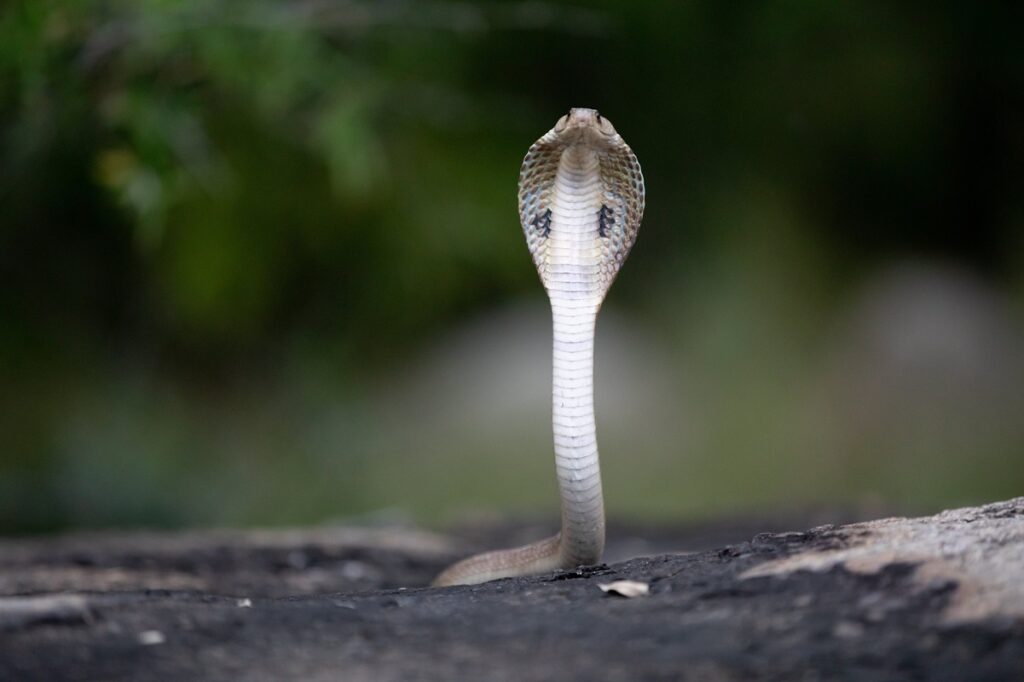
The King Cobra is the world’s biggest venomous snake. It lives in west Bali. It’s olive or brown with light stripes. This snake’s venom is very strong. It can stop your muscles from working and make it hard to breathe. If this snake bites you in Bali, you need to go to the hospital fast. They don’t have a special medicine for it.
- Appearance: Olive or brown with pale diagonal stripes. The world’s longest venomous snake.
- Habitat: Mainly in rural west Bali.
- Venom Potency: Extremely venomous. A bite can cause muscle paralysis, respiratory failure, and even death.
- Medical Response: No anti-venom available in Bali. Immediate hospitalization is vital.
Javan Spitting Cobra
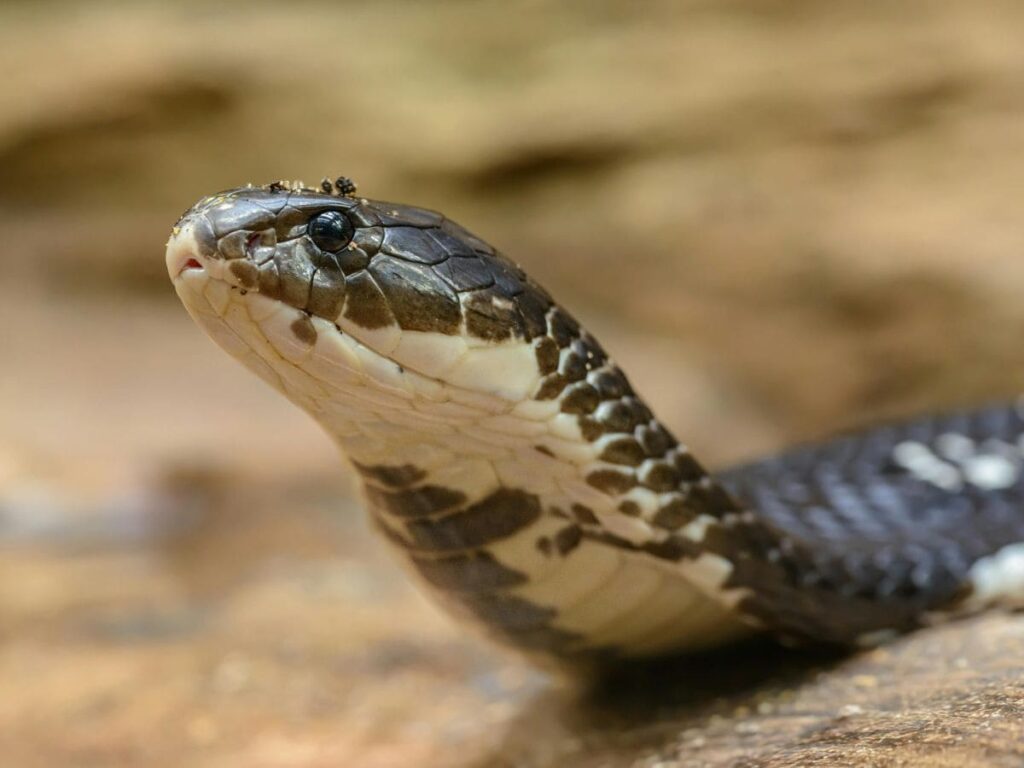
The Javan Spitting Cobra lives all over Bali’s countryside. It can be cream or brown. This snake can spit its venom. If it bites you, it can make your tissues swell and hurt. Some hospitals in Bali have medicine for this snake’s bite.
- Appearance: Can vary from light cream to dark brown. Known for its ability to spit venom.
- Habitat: Widespread in rural areas.
- Venom Potency: Venom can cause tissue swelling, necrosis, and respiratory failure.
- Medical Response: Anti-venom is available in some hospitals.
I met this on in the dark in Nusa Penida. Only way I saw it was because of I turned no my phone light. It was a huge scare for both the snake and us. When I alerted the neighboring house, it was shrugged off.
Blue Krait
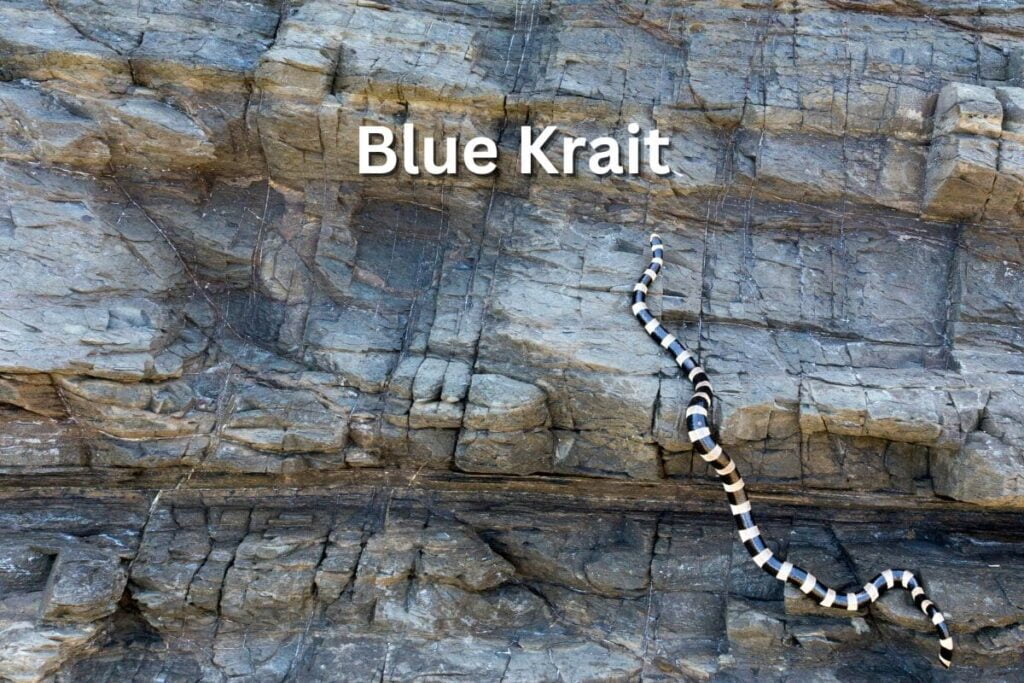
The Blue Krait is not really blue. It has black and white rings or is one color. It comes out at night and after rain. Its venom is very strong. It can hurt your nerves a lot. If this snake bites you, you need to get help fast. Bali doesn’t have a special medicine for it.
- Appearance: Black rings with dirty white rings or all one color.
- Habitat: Active especially after rain and late at night.
- Venom Potency: Highly venomous. A bite can be fatal if not treated.
- Medical Response: No specific anti-venom. Treatment may require assisted breathing.
Banded Krait
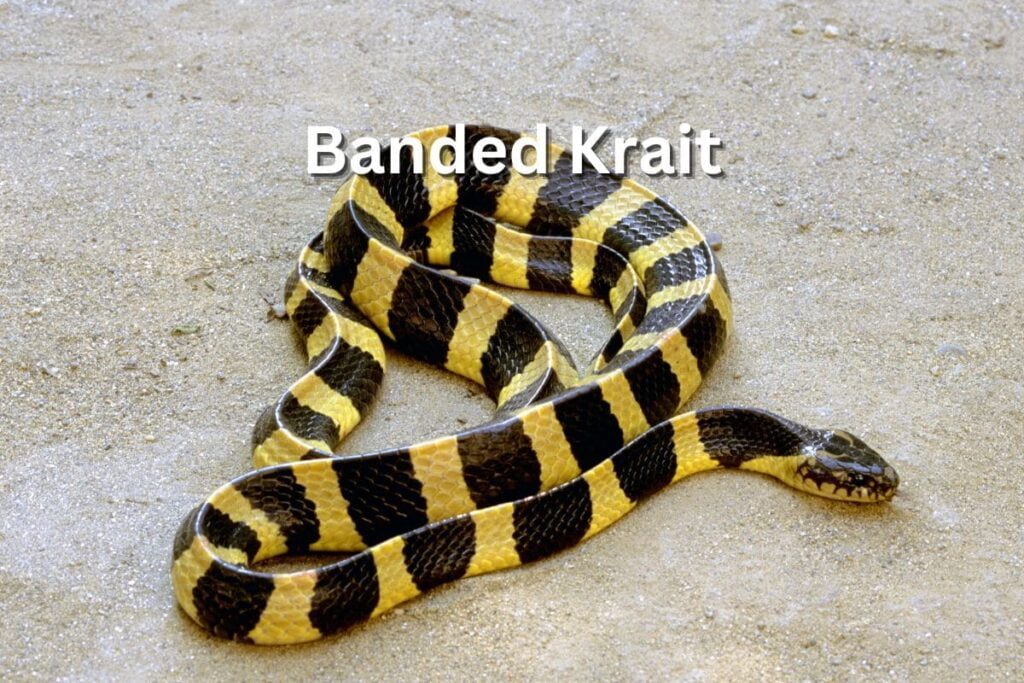
The Banded Krait has black and yellow bands. It lives near rice fields. Its venom is strong and hurts your nerves. If it bites you, you need to go to the hospital right away. Bali has only a little medicine for this snake.
- Appearance: Easily recognizable by its black and yellow bands.
- Habitat: Found along the edges of rice fields.
- Venom Potency: Venom can cause severe neurological symptoms.
- Medical Response: Limited anti-venom availability. Immediate medical attention is necessary.
Banded Sea Krait

The Banded Sea Krait lives in the sea and on land. It has black and grey bands. It’s not usually mean unless you bother it. If it bites you, you need to see a doctor fast. Bali doesn’t have a special medicine for this snake.
- Appearance: Black and grey bands with a paddle-shaped tail.
- Habitat: Common in coastal areas and often seen on land.
- Venom Potency: Highly venomous, but generally non-aggressive unless provoked.
- Medical Response: No specific anti-venom. Treat bites promptly.
Asian Coral Snake
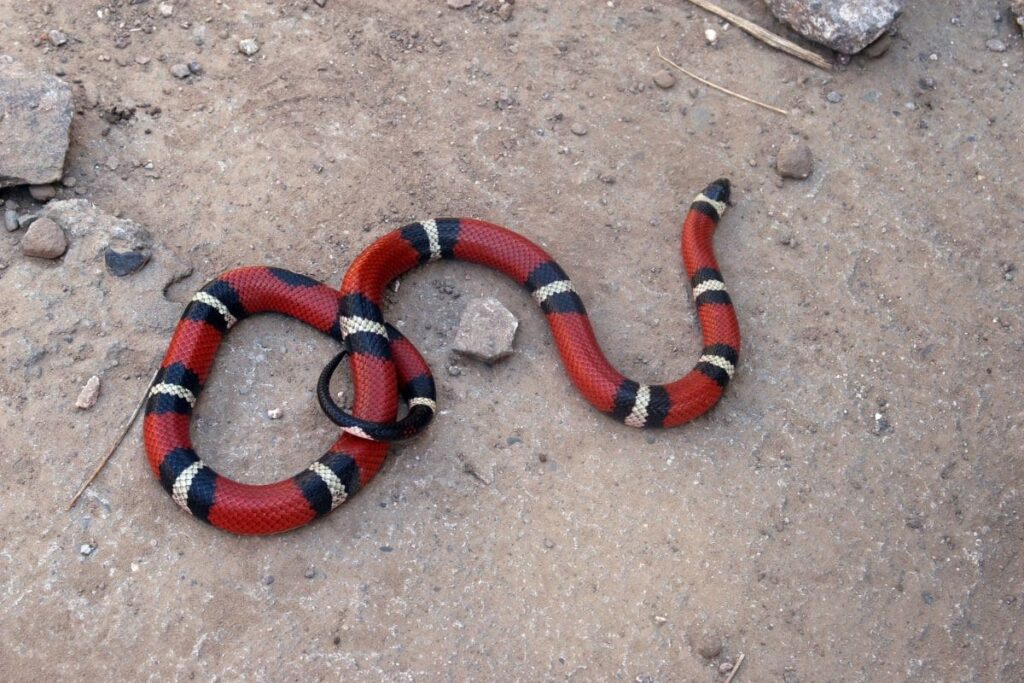
The Asian Coral Snake is small. It likes high places in Bali. It’s less than 35cm long and has an orange line on its back. Its venom is very strong. If it bites you, you need to go to the hospital right away. Bali doesn’t have a special medicine for this snake.
- Appearance: Small, less than 35cm long, with a distinctive orange line along the back.
- Habitat: Prefers higher elevations and burrows in soil.
- Venom Potency: Highly venomous, but bites are rare.
- Medical Response: No anti-venom available. Immediate hospitalization is recommended.
Bali’s The Non-Venomous snakes
Reticulated Python
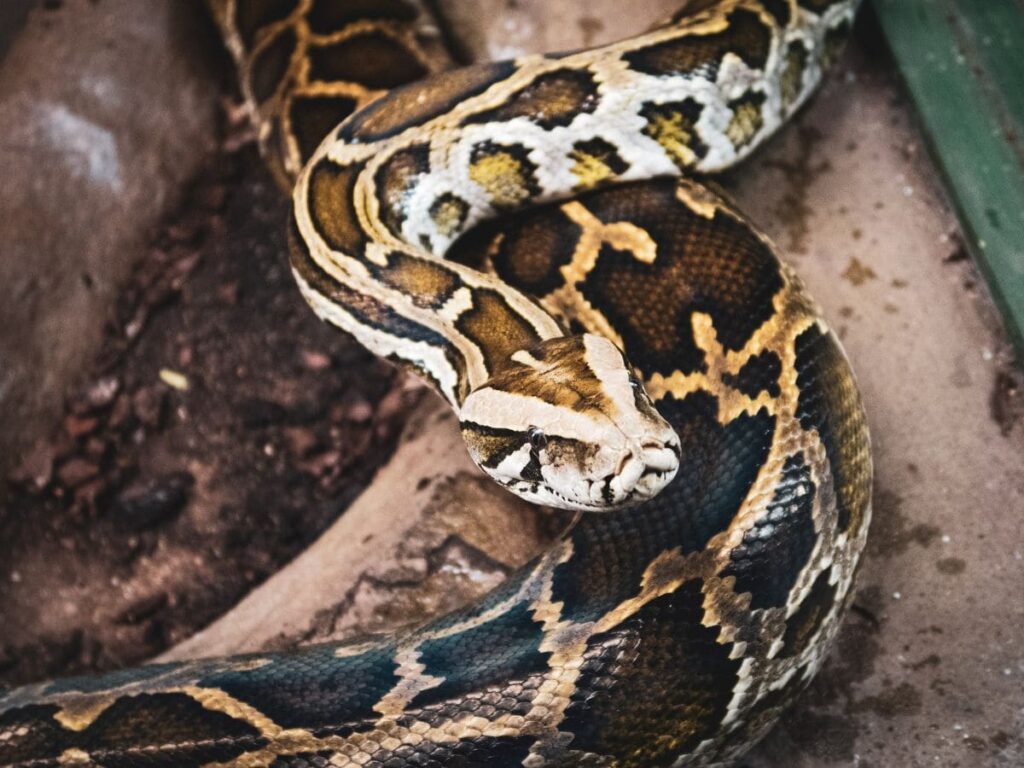
In Bali, the Reticulated Python is one of the largest snakes. It can grow very long and lives in forests and near water. This python eats birds and small mammals, helping control their population. It’s known for its beautiful patterned skin.
Oriental Rat Snake
The Oriental Rat Snake is a common sight in Bali. It’s a fast mover and loves to eat rats and other small creatures. This snake plays a big role in keeping the rodent population in check, which is great for local agriculture.
Green Vine Snake
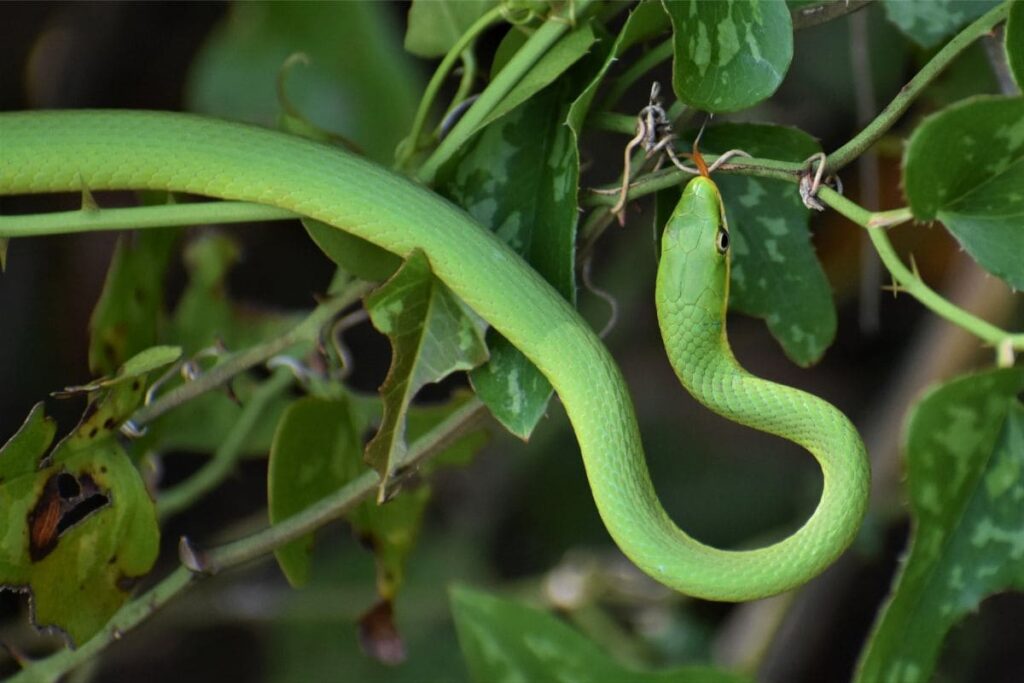
The Green Vine Snake is a slender, green snake that’s great at hiding among leaves. It mainly feeds on insects and small animals, maintaining a natural balance in the ecosystem. This snake is known for its striking appearance and agility.
Sunbeam Snake
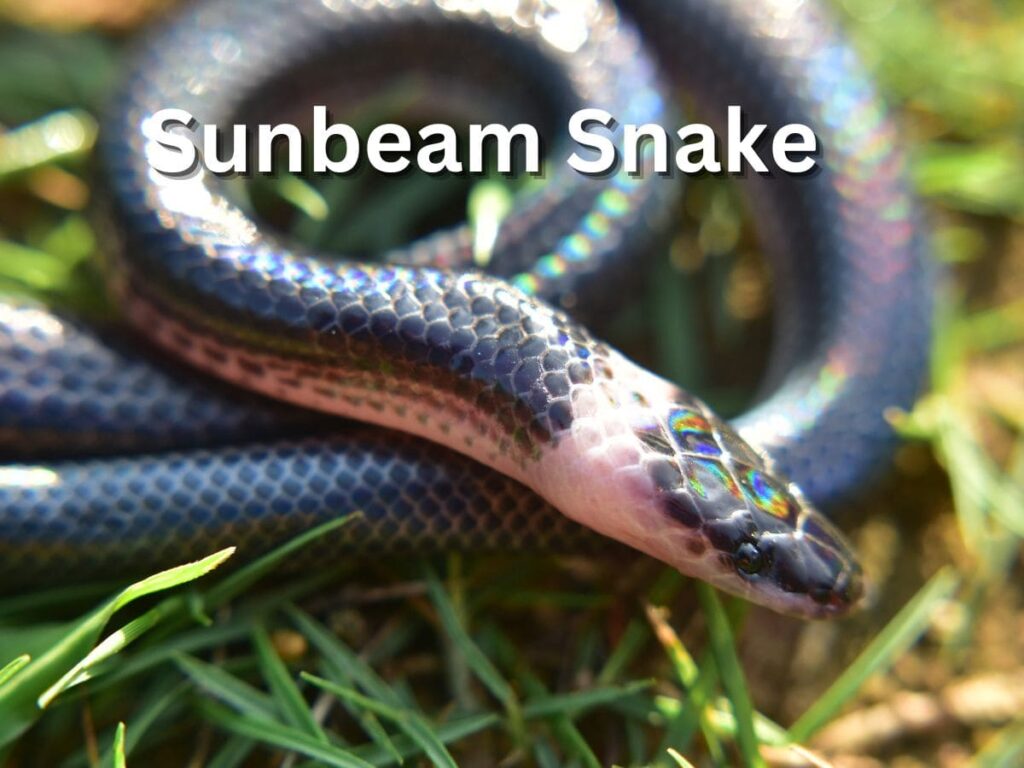
The Sunbeam Snake, with its iridescent skin, is a beauty. It prefers to live underground and feeds on small ground-dwelling creatures. This snake contributes to soil health, which is vital for plant growth.
Striped Keelback
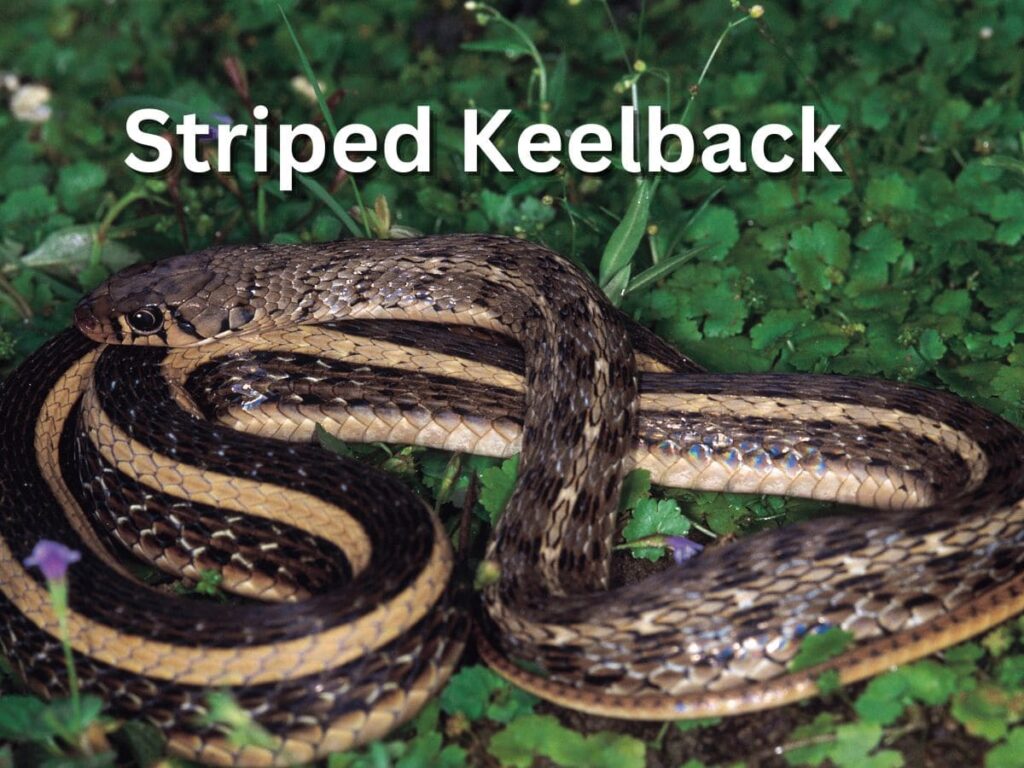
The Striped Keelback is a small, water-loving snake found near Bali’s water bodies. It feeds on frogs and small fish, helping to keep their populations balanced. This snake is recognized for its distinctive stripes and mild nature.
Red-Tailed Racer
The Red-Tailed Racer is known for its speed and agility in the trees. It preys on birds and eggs, playing a role in controlling bird populations. This snake is easily identified by its vibrant red tail but a overal green.
Painted Bronzeback
The Painted Bronzeback is a colorful tree dweller. It mainly eats insects, aiding in pest control. This snake is admired for its striking colors and contributes to the ecological balance in Bali’s forests.
Final Thoughts
As we wrap up our snake journey in Bali, let’s remember how important these creatures are. They’re not just fascinating to learn about; they play a big role in nature. Snakes help control pests like rats and insects. This keeps the food chain in balance. It’s all part of Bali’s rich and diverse ecosystem.
It’s all about respecting nature. This means being careful and smart around snakes. If you see one, it’s best to leave it alone. Remember, most snakes won’t bother you if you don’t bother them. By being responsible, we can enjoy Bali’s natural beauty safely.
I’ve encountered more than a handful of snakes, some even close encounters, stay calm. These snakes are not out to get you, they most likely don’t want to use their venom on you as this is also rare for them and a kind of last resort almost.
FAQ about Snakes in Bali
Can snakes be found on Bali’s popular beaches?
While it’s rare, some snakes can occasionally be found in less crowded areas of Bali’s beaches, especially near natural vegetation. However, most beach areas are too busy and well-maintained for snakes to be comfortable.
Are there any specific times of year when snake sightings in Bali are more common?
Yes, snake sightings in Bali tend to increase during the rainy season, as many species are more active and visible during this time.
What should I do if I find a snake in my hotel room in Bali?
If you find a snake in your hotel room, stay calm and avoid disturbing it. Contact hotel staff immediately for assistance, as they can call someone to safely remove the snake.
Is it safe to go hiking in Bali’s forests considering the presence of snakes?
Yes, it’s generally safe to hike in Bali’s forests. However, it’s important to stay on marked trails, wear appropriate footwear, and be vigilant about your surroundings to avoid unexpected encounters with snakes.
How can I differentiate between venomous and non-venomous snakes in Bali?
Answer: Differentiating between venomous and non-venomous snakes can be challenging. It’s best to assume all snakes could be venomous and maintain a safe distance.
Hi I am Dwi. I am a blogger, travel agent and a mom of a lovely daughter and wife to a supportive husband. I customize and plan tours in Bali and islands nearby for a living and have been doing this for more than 14 years. Get in touch via contact [at] taletravels.com
